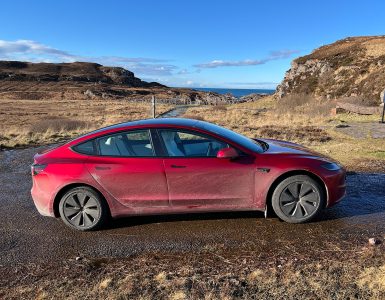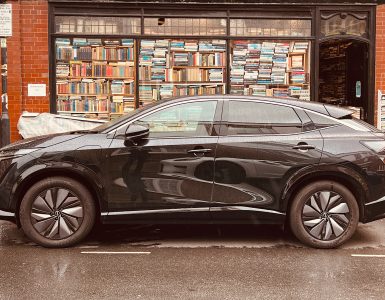There is a consensus that EV vehicles are the future. So when will sales start rising and how soon before rising EV sales are greater than (falling) sales of diesel cars.
While some in the industry say EV sales aren’t taking off because there aren’t enough charging points and buyers aren’t ready to switch the reality is mainstream customers (rather than keen early adopters) want EV’s that are as practical as their existing cars, similar in price and with a range in the real world of at least 200 miles. So how many EV’s on sale deliver that?
Electric Cars – a journey

In the last 10 years electric cars have been transformed from low powered miniature death traps like the pioneering Gee Whizz to incredible high end performance Teslas that can beat a supercar off the lights and carry a family as well.
A single charge can now provide an EV with a WLTP official range of around 300 miles which translates to 230 to 275 miles in real world use. On the fastest chargers these cars can now add a couple of hundred miles of range in a 40 minute charge and models due in 2020 onwards hope to get this time down to only 15 minutes or so. This capability makes an EV capable of almost any journey in the UK or across Europe where the latest fast 100 kWh chargers are already installed. Faster chargers than this are on the way.

The thing is, out of the EV cars currently on sale at the end of 2018, only a tiny number have these capabilities, and they don’t cover the biggest selling segments of the car market.
The biggest selling EV, the Nissan Leaf actually doesn’t have very long range at all until a much needed upgrade. Worse still on long journeys it can only “fast charge” once a day because, unusually, it can’t manage the temperature of its batteries. Most EV’s on sale in Europe have a decidedly short, second car range of under 125 miles ( or even under 100 miles) in the real world and some have very long charging times as well.
In terms of market segments the longer range EV’s have been concentrated in a few smaller segments of the new car market. Until the model 3 arrives in Europe Tesla is in a small segment for very large SUVs and luxury Saloons costing over £70,000. The Jaguar I-Pace is a more practical size but also super high performance and only a little lower in price. The Hyundai Kona is the only only compact EV under £40,000 that can deliver well over 200 miles of range on the road. It is an attractive efficient SUV, but just a little small to take families with luggage on a trip. There is no long range family EV SUV for Nissan Qashqai money with Qashqai practicality. Nor is there a long range hatchback that is in the same space as a VW Golf.
2019 – the year America (Tesla) and Korea (Hyundai & Kia) get a free run in Europe
2019 will be about some delivery and a lot of anticipation. Tesla will be bringing their Model 3 to Europe with deliveries starting in February 2019, although the UK will have a longer wait. Despite the styling this is a saloon in a hatcback shape. With production now up to 300,000 annually the model 3 has become the best selling car in the compact executive class in the US, outselling cars like the BMW 3 series and Mercedes C class. It is now the 4th best selling car of any kind in the US and looks like it may reach the top spot. Will it repeat this success in Europe? Time will tell but

European diesel and petrol saloons like the just launched 3 series look like yesterday- the model 3 looks like tomorrow.
Certainly the model 3 is much more of a Europe friendly size compared to the big model S and model X. The Europeans carmakers are fortunate they only face an EV saloon. The most dangerous Tesla, the Model Y, a practical long range compact SUV won’t be launching until after 2019 and is likely to launch in key US markets first.

Hyundai and Kia are sister brands from Korea and they are likely to get visitors to their showrooms that have never looked at a Korean car before. Why? Well they are bringing 3 cars to market that offer amazing range (in the real world as well) and fast charging all at an affordable price. For £30,000 to £37,000 these Korean wonders (the Kona, Niro and Soul) are offering a range close to a Model 3, a little more than a Jaguar I-Pace and much more than the £60,000 to £80,000 first round of EVs from Audi, Mercedes and BMW that haven’t even arrived with customers yet. Will they sell? Well deliveries for the first model, the Hyundai Kona are taking over 10 months from ordering as at Christmas 2018. So yes… Koreans will he selling as many EV’s as they can make in 2019 especially when the Kia Niro and Kia Soul arrive on sale. The Niro in terms of space will finally come close to offering a Golf sized practical family car although it has least interesting and oldest design of the 3 long range Korean models.
Will the German carmakers enter the fray? Only on the edges. The Audi e tron should finally reach some customers in the first 2 quarters of 2019 while the 4th quarter will see the arrival of the Mercedes EQC.
The Mercedes & Audi are both all new models designed to be EV from the outset and in the same price segment as the Jaguar I-Pace. Both have an offical range of 250 miles so they are only likely to scrape into the 200 mile yardpost on the road.
Autocar has provided a schedule of EV launches through to late 2020. Bear in mind first deliveries can be around a year after some models are launched.
2020 – Volkswagen enters the long range EV market in a key segment
By the start of 2020 Volkswagen starts to hit the ground running with the arrival of the ID, or Neo or whatever name it launches with. This rear wheel drive EV will offer official range of over 300 miles, be Golf sized on the outside and as spacious as a Passat on the inside. All for the price of a diesel Golf.
After all its problems with cheating over toxic diesel emissions it’s not surprising that VW have been first to exit from the German carmaker consensus. Mercedes and BMW still believe EVs will have their place, but “we will still be selling diesels in 2030”. By contrast VW is, at the end of 2019 committed to an EV future. They are converting key car factories to EV only production, are building their own dedicated battery supplies and in essence are betting on an EV future. The more equivocal attitude to EVs at BMW and Mercedes is the more risky bet. It is hard to see how the internal combustion engine will remain dominant against EV’s that will be cheaper, faster, more efficent with zero CO2 and no toxic emissions. The only looming issue for EVs will be how to recycle all the batteries one day. This needs to be planned and regulated for now.
Despite all the investment unless initial plans move up a gear the VW ID production for 2020 will be limited to around 100,000 cars in 2020. By 2025 VW plan to be making 2.5 million EVs a year. Demand will exceed supply in 2020 just as it does for long range EV’s at the end of 2018. VW plans to handle this by opening order books with deposits probably starting in summer 2019.
2020 sees more EV launches including from Volvo and Polestar backed by Geeley the chinese carmaker. An EV Volvo XC40 with 300 miles of range looks to be on the cards. The same tech will arrive first in the Polestar 2 EV.
BMWs first offering will an electric version of the existing X3 SUV. Although less exciting in design the X3 if priced right could provide a sales surprise as it sits in a mainstream £35,000 to £45,000 segment in diesel and petrol form. The question is will this spec be in demand when VW sell a longer range ID for less money. The VW ID Cross SUV with similar range should be on sale by 2021. In addition a lower volume first EV from Dyson may shed light on their future EV offerings.
MyUrbanCar view
2019 looks will provide an opportunity for some carmakers to sell long range EVs while most sit on the sidelines waving press releases about the amazing new EV’s they will launch in 2020 and 2021. The reality is you can’t drive a press release but the 2019 EV’s you can drive won’t be available in sufficient numbers to satisfy demand.
Any carmaker than make over 100,000 of a mainstream long range EV before anyone else will be gamechanging, just as Tesla are being with the model 3 in America. Right now unless Nissan sort out product range and charging issues then VW and Volvo could be first past this yardstick.
Right now diesel is successfully holding onto around 1/3 of new car sales in Europe against mainly petrol powered alternatives. The respite will be short lived. EV availability should go up 10 fold by 2021-23, at which point EV sales should pass falling diesel sales. The tipping point is slowly approaching






